Explore The Things To Do In Badrinath For Divine Journey

Badrinath is a town and nagar panchayat in Chamoli district in the state of Uttarakhand, India. It is a Hindu holy place and is one of the four sites in India’s Char Dham pilgrimage. Badrinath town is also part of Panch Badri temples, including Yog Dhyan Badri, Bhavishya Badri, Adi Badri, Vriddha Badri, and Badrinath temple. Badrinath is located at an elevation of around 3,100 m. There are various things to do in Badrinath that are worth doing for an exclusive travel experience. Located in the Garhwal Himalayas, on the banks of the Alaknanda River, this sacred town lies between the Nar and Narayana mountain ranges.
About Badrinath
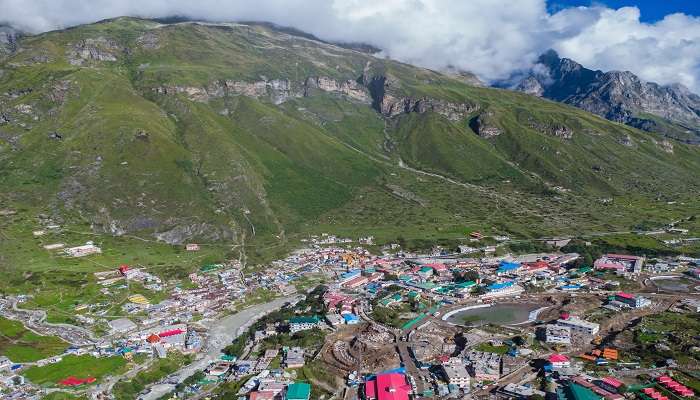
The tourist destination in Uttarakhand, Badrinath, is entwined with mystery and folklore. Badrinath Dham is a religious place where both Nar and Narayan meet. It is located at an elevation of 3,133mts above sea level in the Chamoli district of Uttarakhand state. Of the 108 Divya Desams representing Lord Vishnu’s incarnations, Badarinath is considered a sacred temple for Vaishnavites. Along with the Badrinath temple, the town of Badrinath is home to the Panch Badri temples, including the Yog Dhyan, Bhavishya, Adi, and Vriddha Badri.
Must Read: Tourist Places In Badrinath
Things To Do In Badrinath
In the holy city of Badrinath, there are many things to explore in the holy abode of divinity. Here are the curated list of things to do in Badrinath :
1. Visit Badrinath Temple
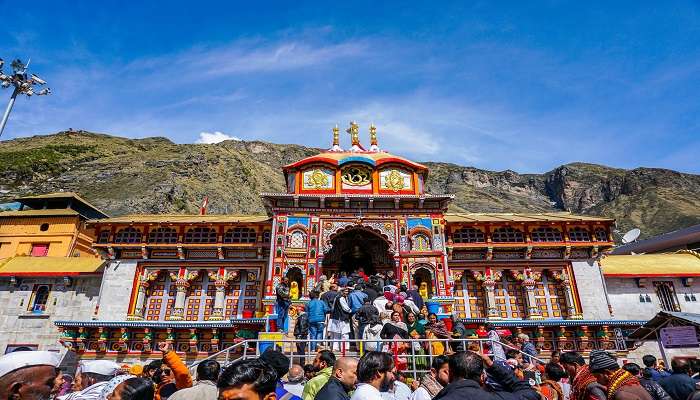
Badarinath or Badarinarayana Temple is a Hindu temple dedicated to Vishnu. It is situated in the town of Badrinath in Uttarakhand, India. It is situated between the two mountain ranges named Nar and Narayan on the left bank of the Alaknanda River. Badrinath temple is the main attraction in the city. This temple of Lord Vishnu, built in ancient style, is spacious. Its height is about 15 meters. According to legend, Lord Shankar discovered the image of Badrinarayan on a black stone in the Alaknanda river, which was the stone of Shaligram. It was originally made in a cave near the hot troughs Hot Springs.
2. Vasudhara Falls
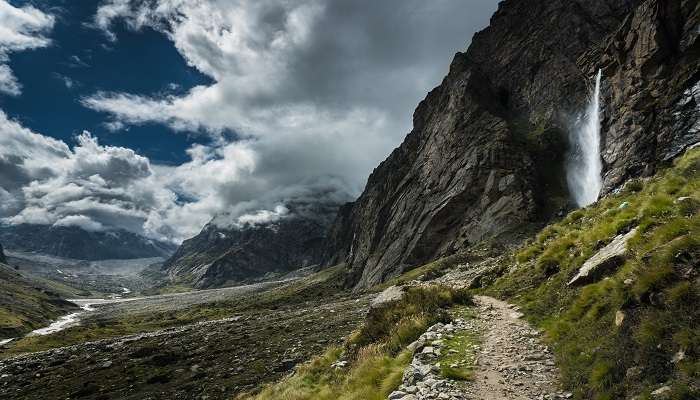
One of the most captivating locations in Uttarakhand is the nectar-sweet Vasudhara Falls, which is rushing close to the sacred city of Badrinath. This breathtaking waterfall descends from 400 feet, or 122 meters, above sea level. Devotees stand under this holy waterfall because the individual it falls upon is believed to be eligible for salvation. This spring is considered to have a flavour like nectar because its water has been enriched by Ayurvedic herbs, such that the person on which its water falls becomes healthy. It is a 3-kilometer trip from Badrinath to Mana village to reach the breathtaking Vasudhara Falls. It takes two hours to reach the Vasudhara waterfalls after a strenuous 5-kilometre hike from Mana village.
Suggested Read: Hill Stations Near Badrinath
3. Sri Hemkund Sahib
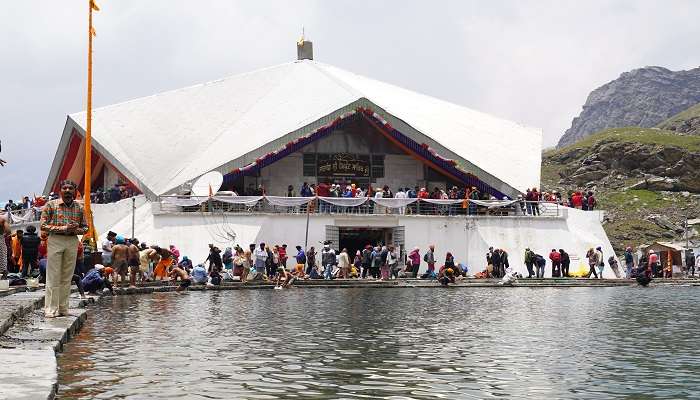
Guru Gobind Singh is the tenth Sikh Guru, and the Gurudwara Hemkund Sahib is dedicated to him. Situated at an elevation of 4329 meters, this gurudwara is encircled by seven peaks of snow-capped mountains. Sikhs and Hindus attend this gurudwara, the highest in the world. The glaciers from Hathi Parvat and Saptrishi peaks feed the lake nearby, and a small Himganga flows out of it. It is said Lakshmana, the younger brother of Lord Rama from the epic Ramayana, regained his health by meditating on the banks of Hemkund after the severe injuries he received in the war. The gurudwara remains enveloped by snow during winter, and every year, in summer, it re-opens for the annual pilgrimage, Hemkunt Sahib Yatra.
4. Valley Of Flowers National Park
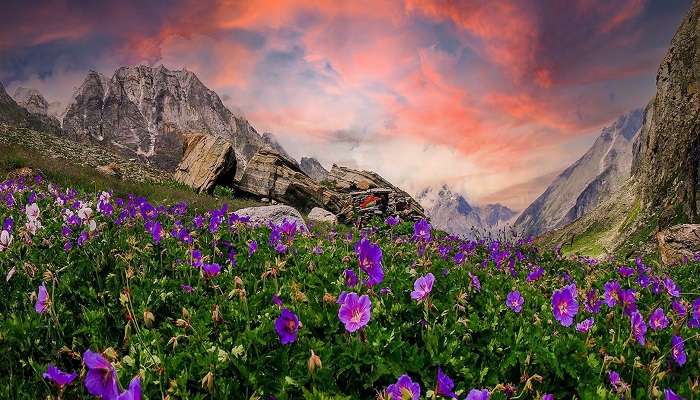
Valley of Flowers National Park is an Indian national park established in 1982. It is located in Chamoli in the state of Uttarakhand and is known for its meadows of endemic alpine flowers and the variety of flora. The valley is accessible only between the months of June and October, and the best time to visit the Valley of Flowers in Uttarakhand is between July and mid-August when it is in full bloom. This national park in India is well-known for its abundant wildlife and plants. The elevation above sea level is 3352–3658 meters. the Valley of Flowers can only be reached by trekking. The nearest motorable road is Govindghat, about 16 km from the valley.
Suggested Read: Last IndianVillage Mana
5. Satopanth Tal
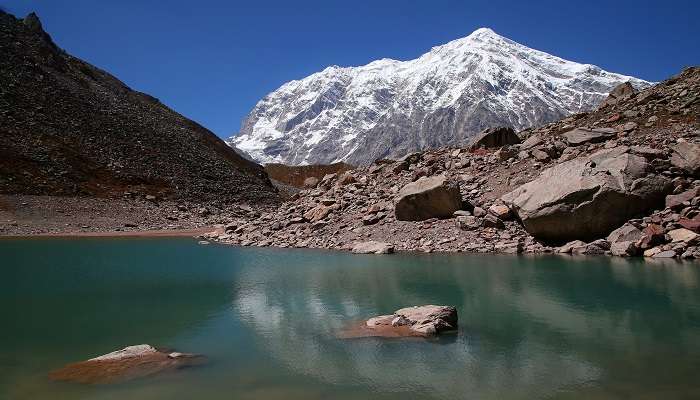
At 4,600 meters above sea level, Satopanth Tal is a lake in Uttarakhand, India, surrounded by snow-capped peaks. The people of Mana village sprinkle the ashes of their deceased loved ones into the lake because they believe it to be sacred. The trek route to the mythical Satopanth Tal, a glacial lake hidden in the Garhwal Himalayas, offers the flavour of high-altitude trekking, walking on boulders, moraine, glacier and knife edge ridge. It is believed that the trimurthis(triple deity of the divinity in Hinduism), Brahma, Vishnu, and Maheswara meditated on its three corners. Some articles say that at the end of the Mahabharata, Pandavas took the route from Mana village to reach the steps to heaven on the Swargarohini glacier via Satopanth Tal.
6. Bheem Pul
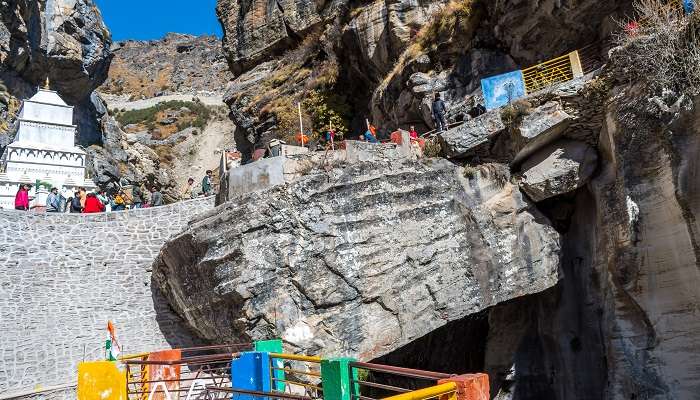
Bheem Pul is located near Mana village, just 3 km from the holy shrine of Badrinath. Bheem Pul is easily accessible by strolling in the direction of Mana village. Situated in the confluence of the Saraswati and Alaknanda rivers, the Bheem Pul can be found at a terrific speed. Legend states that during the Pandavas’ last voyage, known as Swargarohan, to heaven, they passed by a location close to the Badrinath Temple, where they had to cross the Saraswati River. When their wife, Draupadi, could not cross the river, Bheema brought a huge rock and placed it above the river stream to serve as a bridge. That rock is now known as the Bheem Pul and is located in Mana village near Badrinath.
Suggested Read: Places To Visit In Uttarakhand In Summer
7. Bramha Kapal
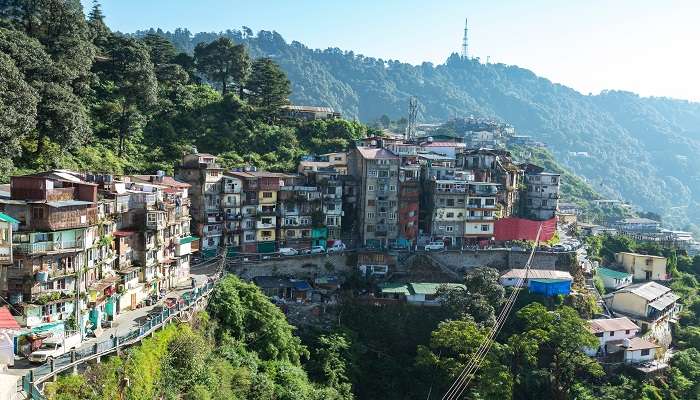
Situated on the banks of the Alaknanda River, Brahma Kapal is an important place in Badrinath for Hindus. It is believed to be where people pay homage to the souls of their ancestors. The last rites of beloved elders are also performed at Brahma Kapal, a flat platform on the banks of the Alaknanda River. Brahma Kapal is easily accessible from the main town of Badrinath and can be reached by a short walk along the banks of the Alaknanda River.
Further Read: Bhavishya Badri Badrinath
Now that you have a list of things to keep in mind for your next vacation to see places in Badrinath. Make sure you plan your trip to Badrinath, these fabulous spots for the experience of a lifetime. Don’t miss out on these opportunities; book your tickets now!
For our editorial codes of conduct and copyright disclaimer, please click here.
Cover Image Source: Neilsatyam for Wikimedia Commons
Frequently Asked Questions About Things To Do In Badrinath
For what is Badrinath widely recognised?
Badrinath is famous because of the 108 Divya Desams that represent Lord Vishnu's incarnations. Badarinath is considered a sacred temple for Vaishnavites. The settlement of Badrinath is a component of the Panch Badri temple complex.
What month is ideal for travelling to Badrinath?
The ideal months to visit Badrinath are April through June when the weather is nice. The average temperature is between 18 and 20 degrees Celsius.
Can we stay in Badrinath?
Even five-star hotels with stunning Himalayan views are available in Badrinath, ranging from basic accommodations ideal for pilgrims to luxurious establishments.
How many days are enough for Badrinath?
Given the abundance of sites in and around Badrinath, two days would be required to properly tour the town and its surrounding area at a leisurely pace. To complete all the places given on this list, you would need at least two weeks, with a few days earmarked for Mana village and a trek planned out for Satopanth.
What dish is Badrinath famous for?
When it comes to food, Badrinath is famous for its Thechwani dish. It is a special Pahadi or mountain region dish. You should be able to find it available at any of the local Badrinath restaurants.
People Also Read:
Things To Do In Kerala Things To Do In Ooty Things To Do In Rishikesh

Passionate Marketing Student with a flair for storytelling, eagerly embarking on a journey within the vibrant world of travel. Excited to merge analytical acumen with creative skills to elevate the editorial landscape of the travel industry.











